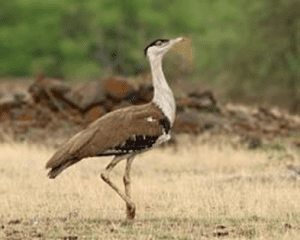TAG: GS 3: ECOLOGY AND ENVIRONMENT
THE CONTEXT: The Great Indian Bustard (GIB), a critically endangered species, faces multiple threats to its survival, primarily stemming from human activities.
EXPLANATION:
- The recent focus on power lines and their impact on GIB habitats has brought to light the complex interplay between conservation efforts and infrastructure development.
- The primary threat to the GIB stems from overhead power lines that crisscross its habitat in the Kutch and Thar deserts of western India.
- These power lines pose a significant risk to the birds, particularly due to their large size and limited frontal vision, making them vulnerable to collisions.
- Studies indicate that power lines result in substantial bird mortality, with an estimated 84,000 bird deaths annually in the GIB habitat alone.
- The GIB’s inability to detect power lines from a distance and maneuver around them exacerbates the threat, leading to collisions and fatalities.
Court Orders and Government Response:
- The Supreme Court’s order to bury underground all power lines in GIB habitats reflects the urgency of addressing this threat.
- However, the Centre has argued that implementing such measures is impractical and financially burdensome, citing constraints such as transmission losses, maintenance challenges, and safety concerns.
Feasibility and Cost Considerations:
- The Centre contends that burying power lines, especially those of 66 KV and higher voltage, is not feasible for bulk power evacuation due to technical limitations and exorbitant costs.
- The estimated expenses run into thousands of crores, posing a significant challenge to implementation.
- While the court has proposed burying power lines as a solution, the Centre has highlighted the use of bird diverters as a more cost-effective alternative.
- However, concerns remain regarding the effectiveness of diverters in preventing bird collisions, especially for large birds like the GIB.
Other Threats to GIB:
- Power lines are not the sole threat to the GIB.
- The proliferation of free-ranging dogs, hunting, pesticide use, and habitat loss pose additional challenges to the bird’s survival.
- These multifaceted threats require comprehensive conservation strategies beyond addressing power line collisions.
Conservation Efforts:
- The government has initiated various conservation initiatives, including captive breeding and habitat restoration, to protect the GIB.
- However, the success of these efforts hinges on mitigating infrastructure-related threats and securing safe habitats for the bird’s population to thrive.
Balancing Development and Conservation:
- The debate surrounding power lines underscores the need to balance development goals with wildlife conservation objectives.
- While renewable energy projects hold promise for sustainable development, they must be implemented responsibly to minimize their impact on endangered species like the GIB.
Great Indian Bustard:
- It is known as the Indian Bustard, is a majestically large bird found on the Indian subcontinent.
- It is one of the heaviest flying birds in the world, with males reaching up to 1.2 meters (4 feet) tall and weighing in at 15 kg (33 pounds).
- These birds are easily distinguished by their black crown contrasting with their pale neck and head, and their brownish body with black, brown, and grey markings on their wings.
- The Great Indian Bustard is classified as critically endangered. Once common on the dry plains of India, there are only an estimated 150 individuals left in the wild.
- There are two main threats to their existence: habitat loss and hunting.
- Their natural habitat consists of large expanses of dry grasslands and scrub. However, this habitat is being lost due to agricultural development, overgrazing, and the planting of trees. Great Indian Bustards are hunted for their meat and feathers.
- The great Indian bustard was distributed throughout Western India, spanning 11 states, as well as parts of Pakistan. Its stronghold was once the Thar desert in the north-west and the Deccan plateau of the peninsula. Today, its population is confined mostly to Rajasthan and Gujarat.

SOURCE: https://indianexpress.com/article/explained/great-indian-bustard-threats-conservation-power-9240502/
Spread the Word
